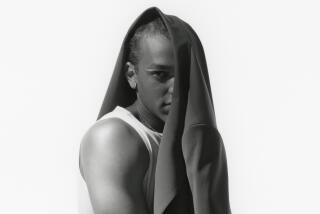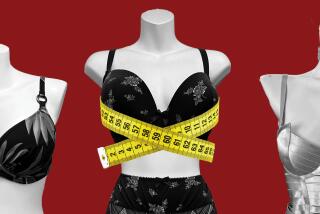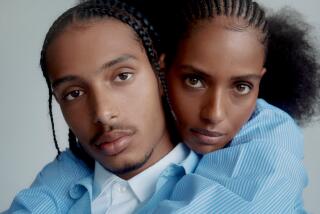Because Sizes Aren’t Written In Stone : How You, Too, Can Be a Fine Figure of a Man
- Share via
If your shoulders slope like a downhill ski run . . . if your feet are Size 13D . . . if your poor excuse for a derriere doesn’t begin to fill out a normal pair of trousers . . . what’s a guy to do?
Well, here are seven of the most common fit problems men encounter, along with possible solutions.
*
Problem No. 1: Suit Size. Regardless of a man’s shape or size, he’ll rarely find a suit that doesn’t need some kind of alteration. The problem is, most suits are sold with a six-inch drop--the difference between a man’s chest and waist size. If you happen to be a large, small or more athletic man with broad shoulders and a small waist, the problem is compounded.
“A guy who wears a Size 44 jacket and has a 32-inch waist can’t be fit off the rack,” says Beverly Hills retailer Sami Dinar. “It’s a very difficult alteration to turn a Size 38-waist pant into a Size 32. It’s never going to work.”
Solution: Many stores--including Brooks Brothers, J. Crew, JCPenney and Sears--sell suit separates, allowing the customer to buy the jacket and pants separately. These suits are hundreds of dollars less than designer suits. Jackets from Palm Beach’s Suited for You program, for example, start at $245; trousers are priced from $105. Many department stores also carry “athletic-fit” suits. These feature a longer, eight-inch drop; thus, Size 40 Regular jackets come paired with 32-inch-waist trousers. At Robinsons-May, prices on athletic-fit suits start at about $200. If a man insists on wearing designer suits, retailers suggest custom-ordering during designer trunk shows. This usually adds about 5% to the price of the suit.
*
Problem No. 2: Neck Size Versus Sleeve Length. Shopping for a dress shirt is a confusing numbers game. Shirts are sold by neck size and sleeve length, with the most common combination (16 1/2-inch neck, 34/35-inch sleeve) the easiest to fit and find. “Most dress-shirt makers tend to group sleeve lengths 34/35 together, so the consumer has to ask himself which (size to buy),” says Dana Peppin, quality-assurance manager at Lands’ End. If you happen to be among the 65% of the male population who does not fall within that average size range, you have a problem.
Solution: Most stores don’t have space to stock endless varieties of sizes. Popular dress-shirt makers John Henry, Hathaway and Arrow all use combined sizing. They insist the half-inch variation is barely noticeable. But what about the man with a 16 1/2-inch neck and a 37-inch sleeve? Mail-order houses supply a broader selection of styles and sizes in a limited range of fabrics. Land’s End carries shirts with 16 1/2-inch necks to Size 37 sleeve, from $20 to $30. The Custom Shops, a 74-unit chain, does 80% of its business in “semi-custom-made” shirts, for which customers’ necks and sleeve lengths are hand-measured. Shirts made of Sea Island cotton range from $47 to $99.
*
Problem No. 3: The Odd-Size Hem. Although half the male population has an odd-size waist and hem (29, 31, 33), most jeans makers cut pants in even inseam sizes only. “It’s an issue of supply and demand,” says Jill Novak Lynch of Levi Strauss & Co. “Our 501 jeans come in a broad array of waists and inseams because the demand is so high. But most of our Red Tab jeans come in only even inseam lengths.” Do you buy the shorter or longer length?
Solution: Jean makers advise customers to buy jeans with waist and length a size larger to accommodate shrinkage (depending on the finish, most jeans shrink anywhere from a quarter of an inch to half an inch). “If you let them out, you’re going to see the old seam line,” says Lynch. Most jeans are washed after they are sewn and areas under the seam--which haven’t been exposed to detergents and water--will appear darker when the seam is opened.
*
Problem No. 4: The Butt-Less Wonder. The problem with having a flat backside is that trousers tend to bag in the most unflattering places.
Solution: “If you have no backside, you want to avoid flat-fitting trousers,” says Peppin of Land’s End. Stay away from worsted wools, linens and wool crepes. Bulkier or textured-fabric trousers add volume where none exists. “Cargo or patch pockets also create a kind of distraction,” she adds. Or you might want to try International Male’s patented undergarment, called Buns. A contour stitch in the back of the $6 briefs (sold through the company’s Undergear catalogue) helps lift and shape--kind of like a Maidenform bra.
*
Problem No. 5: Beer Belly. This is the no-butt problem in reverse. While most men want to accent their backsides, they would rather camouflage a growing gut.
Solution: Look for cotton slacks with side or back elastic, so the trousers expand and contract. “The ability for pants to expand with weight gain is what’s important,” says Cindy Connelly of the King Size Catalog. In addition, “the bigger the belly, the higher the rise of the pants needs to be to cover the extra weight.”
Massimo Iacoboni, fashion director of the Fashion Assn. trade group, adds that men with large stomachs should also try to avoid contrasting colors, such as a dark suit with a white shirt. “Instead wear a dark suit with a dark turtleneck or a mid-tone shirt so you don’t break the waistline. The idea is to have the eye glide over that area rather than be attracted to it.” Iacoboni says a double-breasted suit helps conceal the problem altogether.
*
Problem No. 6: Big Feet. Almost 70% of the body’s bones are in the feet. So it makes sense that proper shoes are one of the most important purchases a man will make.
Solution: Men with large feet should stick with dark brown or black oxfords rather than clunky lug-soled shoes by Timberland or Doc Martens. Most big and tall men’s stores, such as Rochester and Eagleson’s, carry large-size shoes, as do Phoenix and King Size catalogues. They generally stock shoes from Size 12 to Size 19, but King Size will special order many styles, with widths to EEEEE. Many fine shoemakers, such as Johnston & Murphy and Allen-Edmonds, will also custom rebuild any men’s shoe. Simply mail your tired, worn-out brogues to the manufacturer, who will put them back on the assembly line and rebuild them for less than half the cost of new shoes. The only requirement for re-crafting is that the upper leather not be split or torn.
*
Problem No. 7: Sloping Shoulders. Even a good workout program can do only so much to correct weak or sloping shoulders. It’s easy to correct the problem by wearing a suit with padded shoulders. But sportswear is another matter.
Solution: Sweater designer Ron Chereskin says vests and cardigans add volume to men with narrow shoulders. He also says to avoid shirts and sweaters with dropped, dolman or raglan sleeves as well as turtlenecks, which exaggerate the situation. “Turtlenecks fill out the neck at the expense of the shoulders,” he says. A safe bet is to purchase more fully proportioned sweaters, whatever the style. “They add bulk where currently there is none.”






